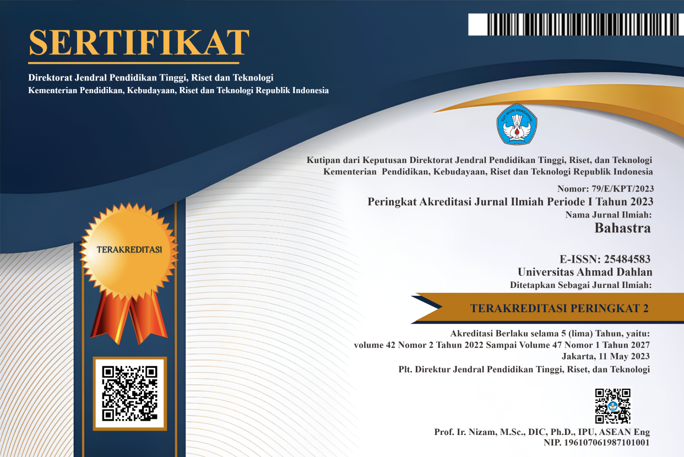Religiosity in Tere Liye’s Janji novel (an Approach to the Sociology of Literature)
DOI:
https://doi.org/10.26555/bs.v43i1.355Keywords:
Religiosity , Sociology of literature, Janji novelAbstract
Novel Janji is one the novels that tell the story of the journey of a religious school child who is looking for a former religious school student decades ago. The author describes religious school children being able to search for someone who disappeared decades ago according to their teacher’s instructions. This study uses a literary sociological analysis approach. The results of the study show that the story in the novel Janji contains five dimensions of religiosity, namely the dimension of belief, the dimension of ritual, the dimension of experience, the dimension of knowledge, and the consequential dimension. In the dimension of belief, it can be seen in the character's belief in doing good, not committing acts of corruption, and the belief in using money to worship. In the ritual dimension, religiosity is seen in the implementation of the five daily prayers, ablution before prayer, Friday prayers, daily expressions, and Idul Fitri prayers. In addition, in the dimension of experience, religiosity is seen in the character's experience of doing bad things, the experience of the character studying at a religious school, and the experience of the character eating inappropriate food for five years. In the knowledge dimension, the value of religiosity can be seen in the concept of sin, the concept of halal and haram, the obligation to pray five times a day, treasures as entrusted in the world, and stories of prophets in the past. At the end, the consequential dimension appears in the actions of the characters in the present which are based on the experiences of the characters in the past.
References
Arikunto, S. (1999). Research procedures a practice approach. Rineka Cipta.
_____________. (2019). Research procedure. Rineka copyright.
Atmosuwito, S. (1989). Regarding literature and religiosity in literature. New Light.
Arora, R., & Stoner, C. (2009). A mixed method approach to understanding brand personality. Journal of Product & Brand Management, 18(4), 272-228. https://doi.org/10.1108/10610420910972792
Austiningsih, I. (2016). Emotions as the basis of literary representations. EnJourMe (English Journal of Merdeka): Culture, Language, and Teaching of English, 1(2), 15-27. https://doi.org/10.26905/enjourme.v1i2.863
Awaliyah, Fatimah, S., & Dian, H. (2021). Religiosity in the Novel Merdeka Since Heart by Ahmad Fuadi. Sebasa Journal, 4 (1), 76-89. https://doi.org/10.29408/sbs.v4i2.3752
Brandt, M. J., & Van Tongeren, D. R. (2017). People both high and low on religious fundamentalism are prejudiced toward dissimilar groups. Journal of Personality and Social Psychology, 112(1), 76. https://doi.org/10.1037/pspp0000076
Creswell, W. J. (2013). Research design qualitative, quantitative, and mixed approaches. Student Library.
Dojosantoso. (1986). Religious elements in javanese literature. Various Sciences.
Hidayat, R., & Santosa, P. P. P. (2019). Analysis of the novel Pudarnya Pesona Cleopatra by Habiburrahman El Shirazy in terms of the sociological aspect of literature. Bahastra Journal, 39 (1), 39-48. https://doi.org/10.26555/bahastra.v39i1.12614
Jassin, H. B. (1983). Indonesian literature history and criticism. Gramedia.
Kelley, M. M., & Chan, K. T. (2012). Assessing the role of attachment to God, meaning, and religious coping as mediators in the grief experience. Death Studies, 36(3), 199-227. https://doi.org/10.1080/07481187.2011.553317
Kent, B. V. (2017). Attachment to God, religious tradition, and firm attributes in workplace commitment. The Journal of social psychology, 157(4), 485-501. https://doi.org/10.1080/00224545.2016.1242470
Kosasih, E. (2012). Dasar-dasar keterampilan bersastra. Yrama Widya.
Leman, J., Hunter III, W., Fergus, T., & Rowatt, W. (2018). Secure attachment to God uniquely linked to psychological health in a national, random sample of American adults. The International Journal for the Psychology of Religion, 28(3), 162-173. https://doi.org/10.1080/10508619.2018.1477401
Liye, T. (2021). Janji. PT Gramedia.
Lubis, M. A. (2017). Culture and social solidarity in religious harmony in Tanah Karo. Sociology of Religion: Scientific Journal of Sociology of Religion and Social Change, 11 (2), 239-258. https://doi.org/10.14421/jsa.2017.112-06
Mangunwijaya, Y. B. (1988). Literature and religiosity. Kanisius.
Maharatih, N. (2017). Religious value in Novel O by Eka Kurniawan. Thesis. Air Langga University.
Neuman, W. L. (2007). Basic of social research: Qualitative and quantitative approach. Pearson Education, Inc.
Nurgiyantoro, B. (2009). Fictional study theory. Gadjah Mada University Press.
Obregon, S. L. (2021). Religiosity, spirituality ,and work: A systematic literature review and research directions. Journal of Business Ethics, 179, 573–595. https://doi.org/10.1007/s10551-021-04856-7
Pertiwi, I. G. A. A. (2020). Forms of deconstruction of gender ideology in out and grotesque Novels by Natsuo Kirino. Aksara Journal, 32(1), 15-30. https://doi.org/10.29255/aksara.v32i1.487.15-30
Putri, R. M. (2018). Religious values in the Novel Love Tasbih in the Sky of Moscow by Indah El-Hafidz. Corpus Scientific Journal, 2(2), 190-199. https://doi.org/10.33369/jik.v22.6524
Ratna, N. K. (2011). Anthropology of literature the role of cultural elements in the creative process. YoStudent Libraries.
Safitri, V. N., & Putra, C. R. W. (2021). Religious values in the Novel Titip Rindu to the Holy Land by Aguk Irawan (study of sociological literature). Paragraph Journal, 2(1), 25-36. https://doi.org/10.35194/alinea.v10i1.964
Sayuti, S. A. (1999). Literature in a learning perspective: Some notes. Paper at the HISKI National Scientific Meeting (Pilnas) HISKI, 18-20.
Sugiyono. (2013). Methods in educational research (quantitative, qualitative and R&D). Alfabeta.
Thurow, J. C. (2013). Does cognitive science show belief in god to be irrational? The epistemic consequences of the cognitive science of religion. International Journal for Philosophy of Religion, 74, 77-98. https://doi.org/10.1007/s11153-011-9300-y
Wallek & Warren. (1989). Literary theory. Gramedia Pustika Utama.
Wiyatmi. (2013). Sociology of literature. Kanwa Publishers.
Wulandari, P. (2021). The religiosity of javanese society in modern Indonesian Literature. Indonesian Community Empowerment Journal, 1(1), 8-13. https://doi.org/10.37275/icejournal.v1i1.3

Downloads
Published
Issue
Section
License
Copyright (c) 2023 Evi Chamalah, Reni Nuryyati

This work is licensed under a Creative Commons Attribution-ShareAlike 4.0 International License.

1.jpg)






